
|
Design your own piezo pickup
Mainly, piezo models to be inserted under the bridge in all types of stringed musical instruments with a movable bridge.
In this case, the pickup is firmly positioned under its left leg by means of a thin 0.2mm thick brass tab, without the need to make any adjustments
to the bridge (cello & double bass).
The "Custom" pickup, according to the client's specifications, is an interesting option for those musicians, builders or restorers who wish to
adapt a sensor to one of their musical instruments, whether plucked or bowed.

With this option you can electrify any modern, ancient, medieval, baroque, oriental, etc. musical instrument.
The only condition, as we have mentioned, is that the bridge is mobile. To make a "Custom Pro" model we need:
- The bridge of the instrument must be movable.
- A photo of the instrument.
- Dimensions of the bridge feet.
- Length of cable from the pickup to the output jack attached to the instrument.
The prices and sales conditions of the "custom" pickups are similar to those offered by the "hi-end" models with the additional advantage of being
sensors specially adapted to the peculiarities of a particular instrument, be it a sitar, viola, viola da gamba, cello,
double bass or others. As an example, we present several models on this page.
|


|
Custom pickups for violin and viola
Double-sensor violin pickup, which allows both bridge legs to be supported. The acoustic quality is practically the same as the standard
single-sensor model, although with the double-sensor pickup the output impedance is lower, allowing for better adaptation and response to
the electronics used. Also, the output voltage is higher, therefore, it does not require the use of a preamp in most practical situations.
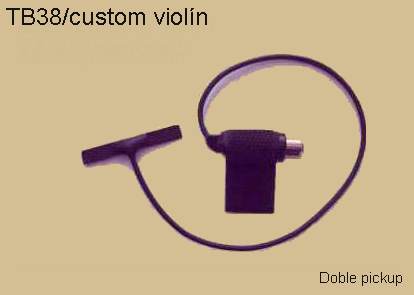
|
|
Custom pickup for cello and double bass
Sensor attachment under the bridge, next to your left foot (looking at the instrument from the front) by means of an extra-thin 0.2mm
thick brass tab. Output by cable whose connector is fixed, as usual, on the tailpiece with VELCRO. With these models it is not necessary, at all,
to retouch the bridge of the instrument.
|
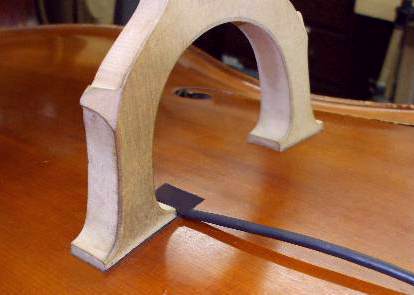
TB38C/CH. (Cello).
Support surface: for the left foot of the bridge according to customer specifications.
Electrical impedance: 12K ohmios approx. (1Khz).
Pickup cable: According to customer specifications.
Output cable: Shielded cable 3m. With RCA/JACK" o JACK/JACK.
Finish: black with extra-fine 0.2mm brass tab.
TB38C/CB. (Double bass).
Support surface: for the left foot of the bridge according to customer specifications.
Electrical impedance: 8 ohmios aprox. (1Khz).
Pickup cable: According to customer specifications.
Output cable: Shielded cable 3m. With RCA/JACK" o JACK/JACK.
Finish: black with extra-fine 0.2mm brass tab.
|
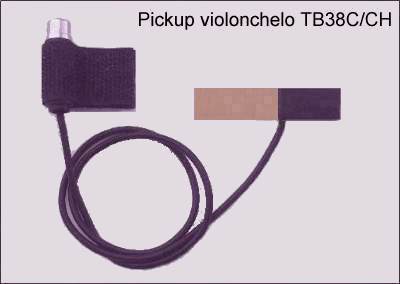 Cello with TB38C/CH Cello with TB38C/CH
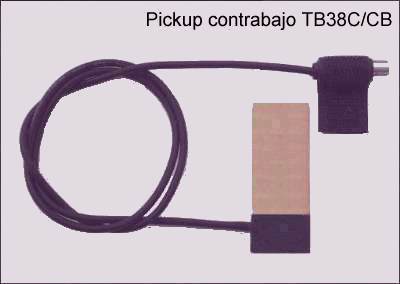 Double bass with TB38C/CB Double bass with TB38C/CB
TB38C/GB. (Guembri).
Support surface: for the left foot of the bridge according to customer specifications.
Electrical impedance: 8K to 12K ohmios approx. (1Khz).
Pickup cable: According to customer specifications.
Output cable: Shielded cable 3m. With RCA/JACK" o JACK/JACK.
Finish: black with leatherette.
TB38C/ST. (Sitar).
Support surface: for the left foot of the bridge according to customer specifications.
Electrical impedance: 12K to 18K ohmios approx. (1Khz).
Pickup cable: According to customer specifications.
Finish: black with extra-fine 0.2mm brass tab.
|
Mechanical correction of frequency response
In our designs, the basis of transduction is barium titanate. The graphs presented below show that, on a medium-sized ceramic substrate,
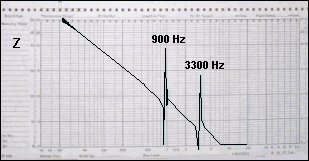 apart from small, rather weak resonances in the upper part of the audio spectrum, easy to correct, there also appear one or two strong
resonances and their corresponding anti-resonances with a high Q factor in the mid-frequency area.
In the attached impedance graph you can see these resonances and anti-resonances reflected in the electrical part of a typical ceramic
vibrating in the air without support or mechanical damping.
apart from small, rather weak resonances in the upper part of the audio spectrum, easy to correct, there also appear one or two strong
resonances and their corresponding anti-resonances with a high Q factor in the mid-frequency area.
In the attached impedance graph you can see these resonances and anti-resonances reflected in the electrical part of a typical ceramic
vibrating in the air without support or mechanical damping.
These resonances also appear in the response curve, somewhat displaced according to the type of support used to obtain the graph
making it impossible to use them in the musical field, as we can see in the following response curve. |
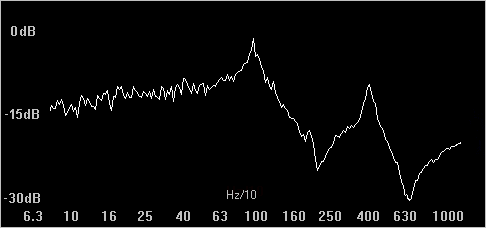
¡Frequency response not suitable for music!
To make this first measurement, we have not applied any damping or correction technique.
The curves were made with a spectrum analyzer and logarithmic sweep adjusting its bandwidth from 50Hz to 15KHz.
By making a design with the appropriate measurements and choosing the appropriate materials, both for the active element and also for the substrate, in addition to using an appropriate damping system, we can move and/or attenuate the resonances to achieve an excellent frequency response. The following graph shows the response curve of our pickup, once it is
mounted in its housing and its own resonances corrected. It is a curve that is completely suitable for use for professional musical purposes. |
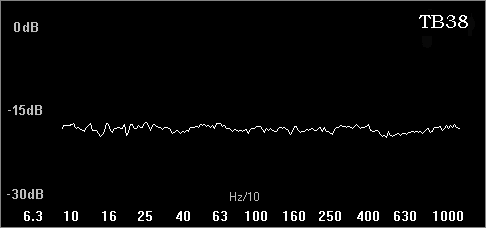
¡Admissible frequency response for Music!

|










